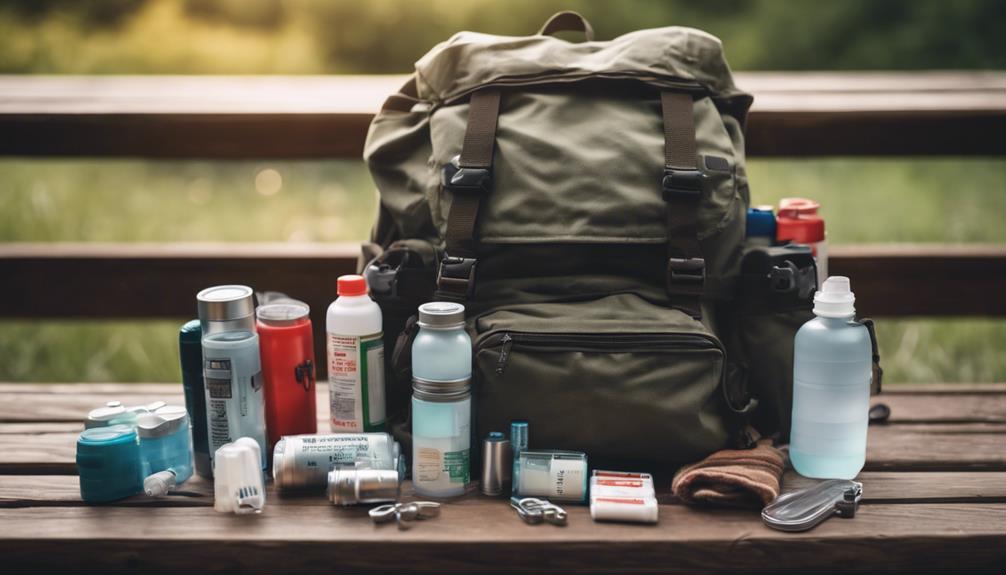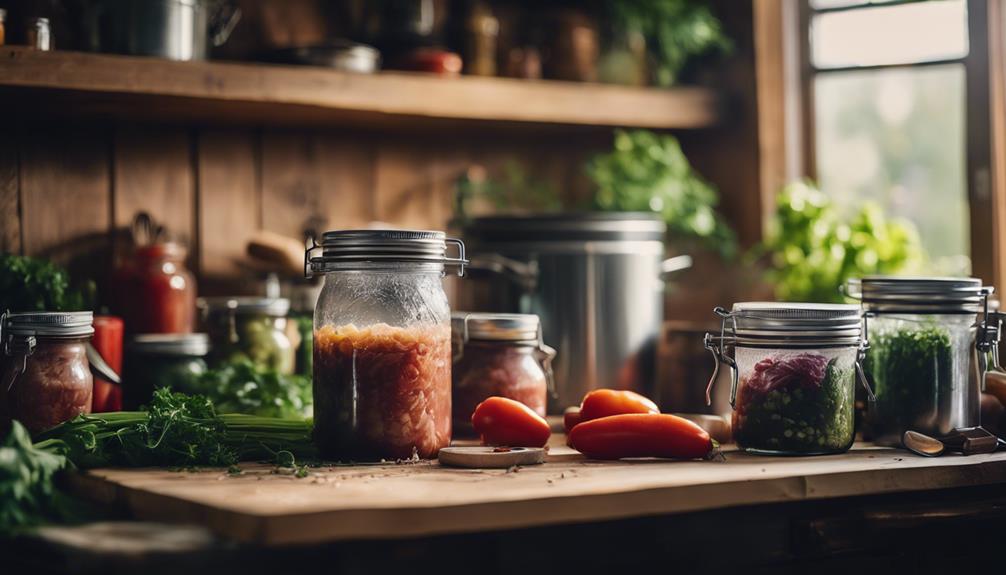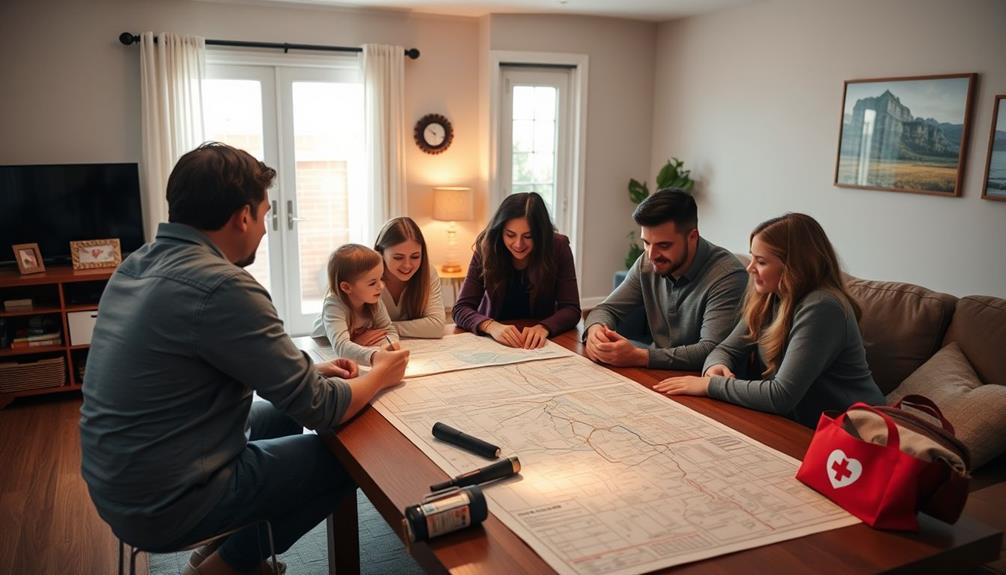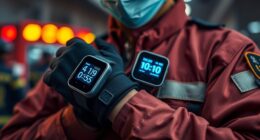To make your own emergency kit, start by gathering essential supplies. You'll need at least one gallon of water per person per day for three days and non-perishable food like canned goods. Don't forget a first aid kit filled with bandages and personal medications. Store these items in an easily accessible, organized container. Remember to include a flashlight, multi-tool, and a battery-powered radio for emergencies. Regularly check and update your kit to replace expired items. Preparing now can make all the difference later, and there's a lot more to reflect on as you build your kit. It’s also important to consider other items such as personal hygiene products, pet supplies, and important documents. In addition to gathering emergency supplies, it’s essential to have a safe room construction plan in place in case of severe weather or other emergencies. This may involve reinforcing a designated room in your home to provide better protection during a disaster. Take the time to create a plan and gather the necessary materials for safe room construction to ensure the safety of you and your loved ones.
Key Takeaways
- Gather at least one gallon of water per person per day and non-perishable food items for at least three days.
- Include a comprehensive first aid kit with antiseptics, bandages, and personal medications for health emergencies.
- Designate a specific storage location for your emergency kit and prepare multiple kits for home, work, and vehicles.
- Regularly inspect and update your kit at least once a year to replace expired items and ensure readiness.
Essential Supplies for Your Kit
To prepare for emergencies, you should gather essential supplies that will sustain you and your family for at least three days. Start with your emergency kit by including at least one gallon of water per person per day—this means you'll need a total of 12 gallons for a family of four.
Next, stock up on non-perishable food that requires minimal preparation, like canned goods and dried fruits. These will guarantee you have adequate nutrition when needed.
A thorough first aid kit is critical; make certain it contains essential supplies such as antiseptics, bandages, and any personal medications. Don't forget to include medical supplies that may be specific to your family's health needs.
Personal care items are also important—pack hygiene products like wet wipes and trash bags to maintain cleanliness.
In addition, consider essential tools like a flashlight with extra batteries, a multi-tool, and a battery-powered or hand-crank radio for communication and visibility during emergencies.
Storage Solutions and Locations

Finding the right storage solutions and locations for your emergency kit can make all the difference in ensuring it's accessible and ready when you need it most. Designate a specific location in your home for your emergency kit, making sure all family members know where it is. Consider preparing multiple kits for your home, work, and vehicles to enhance accessibility during an emergency.
Utilize easy-to-carry containers like plastic bins or duffel bags for your emergency supplies, simplifying transportation if you need to evacuate. Regularly inspect and update your kit at least once a year to replace expired items and adjust supplies based on changing family needs.
Here's a simple table to help you visualize potential storage solutions and locations:
| Location | Storage Solution |
|---|---|
| Home | Plastic bin or duffel bag |
| Work | Smaller backpack |
| Vehicle | Compact emergency kit |
Food and Water Considerations

Having a well-stocked emergency kit also means paying attention to your food and water needs during a crisis.
You'll want to store at least one gallon of water per person per day for a minimum of three days to guarantee adequate hydration.
When it comes to food, choose non-perishable items that require minimal preparation, like canned food. This approach not only saves time but also guarantees you have shelf-stable options that won't spoil quickly.
To maintain nutrition, aim for at least one can of fruits or vegetables per person per day.
Regularly check your emergency supplies, and replace any expired food and water at least once a year to keep everything fresh and safe.
Don't forget to include a variety of beverages like tea, coffee, and juice in your emergency kit; they can provide comfort and additional hydration options.
First Aid and Health Items

A well-equipped first aid kit is vital for managing injuries and health issues during emergencies. To effectively address minor injuries, include essential supplies such as antiseptics, bandages, gauze, and over-the-counter pain relievers. Don't forget to stock medications for chronic conditions and maintain a two-week supply of your personal medication to guarantee health maintenance during emergency situations.
Regularly reviewing medical supplies in your first aid kit is important. Check for expiration dates and replace any outdated items to assure your kit is ready when you need it most. A manual for first aid procedures is also a valuable addition, providing guidance on how to respond effectively when professional help isn't immediately available.
To enhance health and safety, consider adding items like artificial tears for eye relief if you're exposed to smoke and ash, as well as P2 face masks for dust protection. Preparing your first aid kit with these considerations not only ensures you're ready for various emergencies but also supports your overall well-being.
Tools and Emergency Equipment

Equipping your emergency kit with the right tools and equipment can make a significant difference in how you handle unforeseen situations. Here's a list of essential emergency supplies you should consider:
| Item | Purpose | Notes |
|---|---|---|
| Flashlight | Provides visibility during outages | Waterproof models are best |
| Multi-tool | Versatile for various tasks | Compact and handy |
| Whistle | Signals for help | Sound carries long distances |
| Duct Tape | Repairs and temporary shelters | Strong and reliable |
| Plastic Sheeting | Creates barriers or shelters | Useful in multiple situations |
| Battery-powered Radio | Receives updates during emergencies | Essential for information |
| Hand-crank Radio | Alternative power source for updates | No batteries needed |
Conclusion
Creating your own emergency kit is a smart move that can make a real difference when it counts.
Did you know that nearly 60% of Americans don't have an emergency plan? Don't be part of that statistic!
By gathering essential supplies and knowing where to store them, you're taking proactive steps towards your safety.
So, get started today, and enjoy the peace of mind that comes with being prepared for whatever life throws your way!










